最新用英语介绍中国之-1-1-地理位置
中国地理的英文介绍
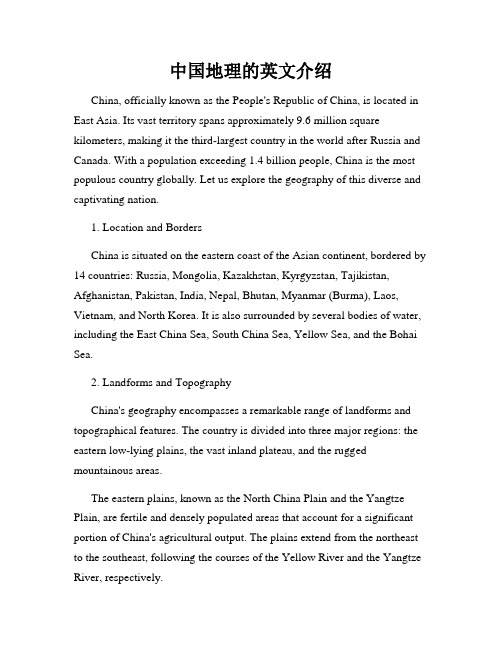
中国地理的英文介绍China, officially known as the People's Republic of China, is located in East Asia. Its vast territory spans approximately 9.6 million square kilometers, making it the third-largest country in the world after Russia and Canada. With a population exceeding 1.4 billion people, China is the most populous country globally. Let us explore the geography of this diverse and captivating nation.1. Location and BordersChina is situated on the eastern coast of the Asian continent, bordered by 14 countries: Russia, Mongolia, Kazakhstan, Kyrgyzstan, Tajikistan, Afghanistan, Pakistan, India, Nepal, Bhutan, Myanmar (Burma), Laos, Vietnam, and North Korea. It is also surrounded by several bodies of water, including the East China Sea, South China Sea, Yellow Sea, and the Bohai Sea.2. Landforms and TopographyChina's geography encompasses a remarkable range of landforms and topographical features. The country is divided into three major regions: the eastern low-lying plains, the vast inland plateau, and the rugged mountainous areas.The eastern plains, known as the North China Plain and the Yangtze Plain, are fertile and densely populated areas that account for a significant portion of China's agricultural output. The plains extend from the northeast to the southeast, following the courses of the Yellow River and the Yangtze River, respectively.The inland plateau covers a substantial area in the northwest and southwest of China. The Tibetan Plateau, referred to as the "Roof of the World," is the highest and largest plateau on Earth, featuring majestic mountain ranges, including the Himalayas and the Kunlun Mountains. The plateau is also the origin of several major rivers, such as the Yangtze, Yellow, and Mekong, which provide vital water resources to downstream areas.China's mountainous areas are predominantly located in the western and southwestern regions. The Kunlun, Tianshan, and Pamir mountain ranges form natural boundaries and provide breathtaking landscapes. Mount Everest, the world's tallest peak, is situated on the border between China and Nepal.3. Rivers and LakesChina is blessed with numerous rivers and lakes, which play a crucial role in its history, culture, and economy. The Yangtze River, stretching for approximately 6,300 kilometers, is the longest river in China and the third-longest in the world. It serves as a historic transportation artery and nurtures the fertile lands along its basin.The Yellow River, known as the "Cradle of Chinese Civilization," flows through the northern part of China, shaping the early development and culture of the region. Other significant rivers include the Pearl River, Hai River, and Heilongjiang River, each contributing to the regional prosperity and ecological diversity.China's vast territory also encompasses several notable lakes. The largest freshwater lake in the country is Lake Poyang, located in Jiangxi Province.Additionally, China hosts the beautiful and picturesque Lake Tai, Lake Dongting, and Qinghai Lake, among others.4. Climate and BiodiversityChina experiences diverse climatic conditions due to its vast size and regional variations. The country displays everything from subarctic climate in the north to subtropical climate in the south. The northeastern region endures harsh winters with cold temperatures and heavy snowfall, while the southern provinces enjoy mild winters and hot, humid summers.China's rich biodiversity is evident in its varying ecosystems and habitats. The country is home to a wide array of plant and animal species, fostering remarkable biodiversity conservation efforts. The giant panda, golden monkey, red-crowned crane, and South China tiger are among the iconic animal species protected within China's nature reserves.5. Megacities and Cultural LandmarksChina is renowned for its vibrant cities and cultural landmarks. Beijing, the capital city, is a cultural and political hub, boasting iconic attractions such as the Great Wall of China, the Forbidden City, and the Temple of Heaven. Shanghai, a global financial center, showcases the Bund, Oriental Pearl Tower, and a modern skyline.Other remarkable cities include Xi'an, famous for the Terracotta Army; Guilin, celebrated for its breathtaking karst landscapes; and Chengdu, home to the adorable giant pandas. These cities, among many others, contribute to China's fascinating blend of tradition and modernity.In conclusion, China's geography is a tapestry of diverse landscapes, ranging from its fertile plains and rugged mountains to its meandering rivers and vast plateaus. Its citizens are fortunate to have an extraordinary range of natural and cultural treasures, making China a truly remarkable country. With its vast dimensions and breathtaking beauty, China continues to captivate and inspire people from around the world.。
英文介绍中国位置的作文
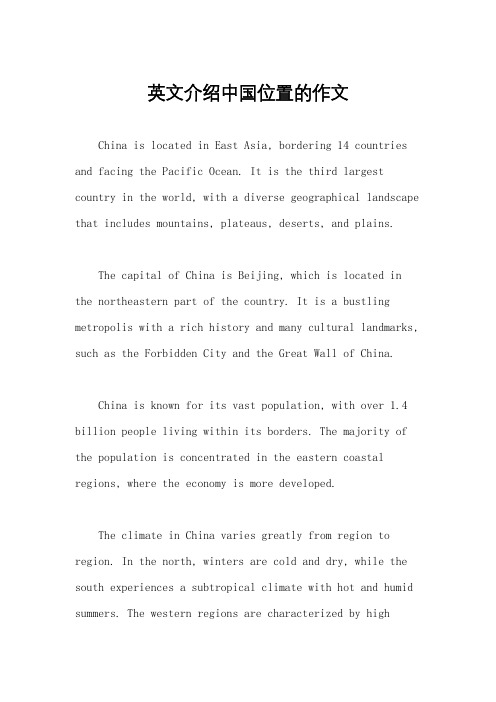
英文介绍中国位置的作文China is located in East Asia, bordering 14 countries and facing the Pacific Ocean. It is the third largest country in the world, with a diverse geographical landscape that includes mountains, plateaus, deserts, and plains.The capital of China is Beijing, which is located in the northeastern part of the country. It is a bustling metropolis with a rich history and many cultural landmarks, such as the Forbidden City and the Great Wall of China.China is known for its vast population, with over 1.4 billion people living within its borders. The majority of the population is concentrated in the eastern coastal regions, where the economy is more developed.The climate in China varies greatly from region to region. In the north, winters are cold and dry, while the south experiences a subtropical climate with hot and humid summers. The western regions are characterized by highaltitude and extreme temperature variations.China is home to a rich and diverse culture, with 56 recognized ethnic groups. Each group has its own unique traditions, language, and cuisine, adding to the country's cultural tapestry.In terms of transportation, China has an extensive network of high-speed trains, highways, and airports, making it easy to travel within the country. The Belt and Road Initiative has also expanded China's connectivity to other countries through infrastructure development.Overall, China's strategic location has contributed to its historical significance as a major global power, andits geographical diversity continues to shape its cultural, economic, and political landscape.。
中国的地理位置的英文介绍

中国的地理位置的英文介绍China's Geographical LocationChina, officially known as the People's Republic of China, is a vast country located in East Asia. With a land area of approximately 9.6 million square kilometers, China is the third-largest country in the world, after Russia and Canada. Its geographical location plays a significant role in shaping its history, culture, and economic development.Situated in the eastern part of the Asian continent, China is bordered by 14 countries, including Russia to the north, Mongolia to the northeast, and North Korea to the east. On its western border lies Kazakhstan, Kyrgyzstan, Tajikistan, Afghanistan, Pakistan, and India. To the south, China shares borders with Nepal, Bhutan, Myanmar, Laos, and Vietnam. Its eastern coast is bathed by the Yellow Sea, the East China Sea, and the South China Sea.China's vast territory is divided into several distinct geographical regions. In the east, the country is characterized by its densely populated and highly developed coastal plain. This region stretches along the shores of the Pacific Ocean and is home to major cities like Beijing, Shanghai, and Guangzhou.Moving westward, the eastern plain gives way to central China's vast river valleys, including the Yangtze and Yellow River basins. These fertile regions have supported agricultural development for thousands of years, making them the cradle of Chinese civilization.Continuing further west, the landscape becomes more mountainous. The vast Tibetan Plateau, often referred to as the "Roof of the World," is locatedin southwestern China. It is home to some of the highest peaks in the world, including Mount Everest, which sits on the China-Nepal border.To the north, the country is bordered by the vast Gobi Desert, which stretches across both China and Mongolia. This arid region is known for its extreme temperatures and harsh conditions, making it relatively uninhabited.In the south, China's terrain is dominated by mountain ranges, such as the Himalayas and the Kunlun Mountains. These towering peaks contribute to China's natural barriers, protecting it from external invasions throughout history.China's geographical location also grants it access to important waterways. The Yangtze River, the third-longest river in the world, flows through the heart of China, providing crucial transportation and irrigation routes. The country's numerous coastal areas offer immense economic potential, facilitating trade and international relations.Furthermore, China's location in East Asia positions it at the crossroads between different cultures and economies. Its proximity to other major powers in the region, such as Japan and South Korea, has fostered economic cooperation and cultural exchanges throughout history.In conclusion, China's geographical location is diverse and complex, encompassing vast plains, mountain ranges, plateaus, and deserts. Its position at the center of East Asia has shaped its history, culture, and economic development. It is a country of immense diversity and natural beauty, making it a fascinating subject of study and exploration.。
用英语介绍中国之1-1地理位置
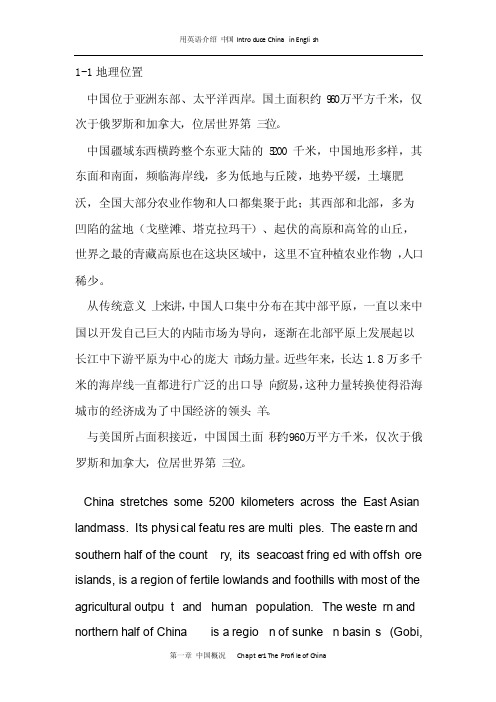
1-1地理位置中国位于亚洲东部、太平洋西岸。
国土面积约960万平方千米,仅次于俄罗斯和加拿大,位居世界第三位。
中国疆域东西横跨整个东亚大陆的5200千米,中国地形多样,其东面和南面,频临海岸线,多为低地与丘陵,地势平缓,土壤肥沃,全国大部分农业作物和人口都集聚于此;其西部和北部,多为凹陷的盆地(戈壁滩、塔克拉玛干)、起伏的高原和高耸的山丘,世界之最的青藏高原也在这块区域中,这里不宜种植农业作物,人口稀少。
从传统意义上来讲,中国人口集中分布在其中部平原,一直以来中国以开发自己巨大的内陆市场为导向,逐渐在北部平原上发展起以长江中下游平原为中心的庞大市场力量。
近些年来,长达1.8万多千米的海岸线一直都进行广泛的出口导向贸易,这种力量转换使得沿海城市的经济成为了中国经济的领头羊。
与美国所占面积接近,中国国土面积约960万平方千米,仅次于俄罗斯和加拿大,位居世界第三位。
Chinastretc hes some 5200 kilome tersacross the East Asianlandma ss. Its physic al featur es are multip les. The easter n and southe rn half of the countr y, its seacoa st fringe d with offsho re island s, is a region of fertil e lowlan ds and foothi lls with most of the agricu ltura l output and humanpopula tion.The wester n and northe rn half of Chinais a region of sunken basins(Gobi,Taklam akan), rollin g platea us, and toweri ng massif s, includ ing a portio n of the highes t tablel and on earth(Tibeta n Platea u) with loweragricu ltura l possib iliti es and thus, far less popula ted.Tradit ional ly, the Chines e popula tioncenter ed on the Chines e centra l plainand orient ed itself toward its own enormo us inland market, develo pingas an imperi al powerwhosecenter lay in the middle and lowerreache s of the Yellow Riveron the northe rn plains, More recent ly, the 18000-kilome terscoastl ine have been used extens ively for export-orient ed trade,making a powershift, with the coastl ine provin ces becomi ng the leadin g econom ic center. With and area of about9.6 millio n km2,the People’sRepubl ic of Chinais the 3rd larges t countr y in totalarea behind Russia and Canada, and very simila r to the United States.。
英语作文介绍一下中国地理位置
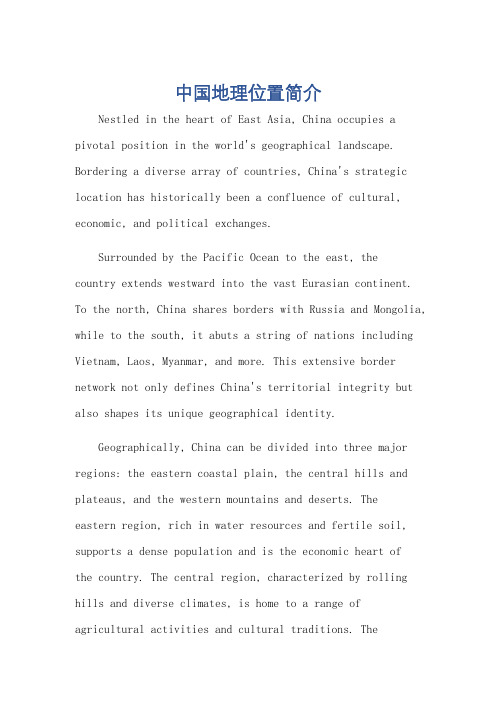
中国地理位置简介Nestled in the heart of East Asia, China occupies a pivotal position in the world's geographical landscape. Bordering a diverse array of countries, China's strategic location has historically been a confluence of cultural, economic, and political exchanges.Surrounded by the Pacific Ocean to the east, thecountry extends westward into the vast Eurasian continent. To the north, China shares borders with Russia and Mongolia, while to the south, it abuts a string of nations including Vietnam, Laos, Myanmar, and more. This extensive border network not only defines China's territorial integrity but also shapes its unique geographical identity.Geographically, China can be divided into three major regions: the eastern coastal plain, the central hills and plateaus, and the western mountains and deserts. Theeastern region, rich in water resources and fertile soil, supports a dense population and is the economic heart ofthe country. The central region, characterized by rolling hills and diverse climates, is home to a range ofagricultural activities and cultural traditions. Thewestern region, with its vast mountains and deserts, isrich in natural resources and strategic minerals.The Yangtze River, the longest river in Asia, and the Huang He or Yellow River, China's second-longest, play a crucial role in the country's hydrology and agriculture. These rivers, along with other major waterways, form a dense network of waterways that facilitate trade and transportation throughout the country.China's geographical diversity also contributes to its diverse climate zones. The southern regions enjoy a subtropical climate with ample rainfall, while the northern regions experience a more temperate climate with colder winters. The western regions, especially those adjacent to the Tibetan Plateau, have a unique highland climate with distinct seasonal patterns.In terms of global positioning, China's geographical location places it at the crossroads of East and West, North and South. This strategic position has historically been a gateway for trade and cultural exchange, making China a natural hub for connectivity and integration within the Asian region and beyond.In conclusion, China's geographical position, encompassing a vast territory with diverse landscapes, climates, and borders, is not only a testament to its rich natural resources but also a catalyst for its cultural, economic, and political influence in the world. This unique geographical makeup continues to shape the country's development and influence in the global arena.**中国地理位置简介**中国位于东亚的心脏地带,在世界地理景观中占据着重要的位置。
介绍中国地理的英语
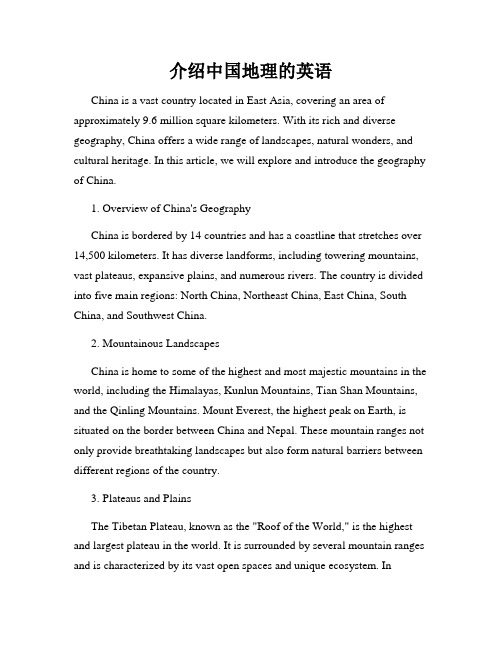
介绍中国地理的英语China is a vast country located in East Asia, covering an area of approximately 9.6 million square kilometers. With its rich and diverse geography, China offers a wide range of landscapes, natural wonders, and cultural heritage. In this article, we will explore and introduce the geography of China.1. Overview of China's GeographyChina is bordered by 14 countries and has a coastline that stretches over 14,500 kilometers. It has diverse landforms, including towering mountains, vast plateaus, expansive plains, and numerous rivers. The country is divided into five main regions: North China, Northeast China, East China, South China, and Southwest China.2. Mountainous LandscapesChina is home to some of the highest and most majestic mountains in the world, including the Himalayas, Kunlun Mountains, Tian Shan Mountains, and the Qinling Mountains. Mount Everest, the highest peak on Earth, is situated on the border between China and Nepal. These mountain ranges not only provide breathtaking landscapes but also form natural barriers between different regions of the country.3. Plateaus and PlainsThe Tibetan Plateau, known as the "Roof of the World," is the highest and largest plateau in the world. It is surrounded by several mountain ranges and is characterized by its vast open spaces and unique ecosystem. Incontrast, the North China Plain and the Yangtze River Delta are major agricultural regions, known for their fertile soil and densely populated cities.4. Rivers and LakesChina is abundant in water resources, with numerous rivers and lakes spread throughout the country. The Yangtze River, the longest river in Asia and the third-longest in the world, flows through the heart of China. The Yellow River, often referred to as the "Mother River of China," has a significant cultural and historical significance. Additionally, vast lakes such as the Qinghai Lake, the Dongting Lake, and the Poyang Lake provide habitats for a variety of plant and animal species.5. Coastal Areas and IslandsChina's extensive coastline spans the East China Sea, South China Sea, and the Yellow Sea. Coastal areas boast bustling cities, thriving industries, and beautiful beaches. Islands such as Hainan Island and Taiwan offer unique landscapes and attract tourists from around the world.6. Climate and BiodiversityChina experiences a diverse range of climates due to its vast size and geographic variations. The country’s climate can range from arid desert climates in the northwest to humid subtropical climates in the southeast. This diversity supports a wide array of flora and fauna, including rare and endangered species like the giant panda and the Chinese white dolphin.7. Cultural and Historical SignificanceChina's geography is deeply intertwined with its rich history and cultural heritage. The landscapes have inspired famous poets, painters, and writers throughout Chinese history. From the Great Wall winding through rugged mountains to the picturesque landscapes of the Guilin region, the geography of China has left an indelible mark on its culture.In conclusion, China's geography offers a fascinating blend of natural beauty, diverse landscapes, and historical significance. From its towering mountains and plateaus to its bustling coastal cities and rich cultural heritage, China's geography is as diverse as its people and traditions. Exploring the geography of China enables us to appreciate the country's vastness and complexity, making it an intriguing and captivating destination to explore.。
英语作文介绍一下中国地理位置
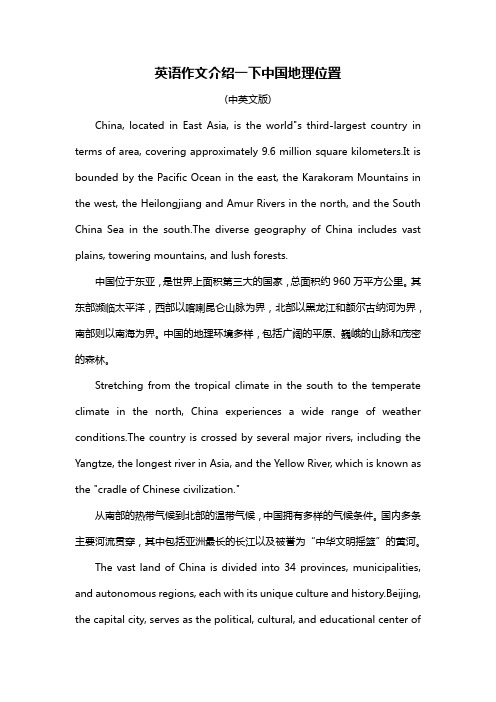
英语作文介绍一下中国地理位置(中英文版)China, located in East Asia, is the world"s third-largest country in terms of area, covering approximately 9.6 million square kilometers.It is bounded by the Pacific Ocean in the east, the Karakoram Mountains in the west, the Heilongjiang and Amur Rivers in the north, and the South China Sea in the south.The diverse geography of China includes vast plains, towering mountains, and lush forests.中国位于东亚,是世界上面积第三大的国家,总面积约960万平方公里。
其东部濒临太平洋,西部以喀喇昆仑山脉为界,北部以黑龙江和额尔古纳河为界,南部则以南海为界。
中国的地理环境多样,包括广阔的平原、巍峨的山脉和茂密的森林。
Stretching from the tropical climate in the south to the temperate climate in the north, China experiences a wide range of weather conditions.The country is crossed by several major rivers, including the Yangtze, the longest river in Asia, and the Yellow River, which is known as the "cradle of Chinese civilization."从南部的热带气候到北部的温带气候,中国拥有多样的气候条件。
介绍祖国的名称和地理位置的英文作文
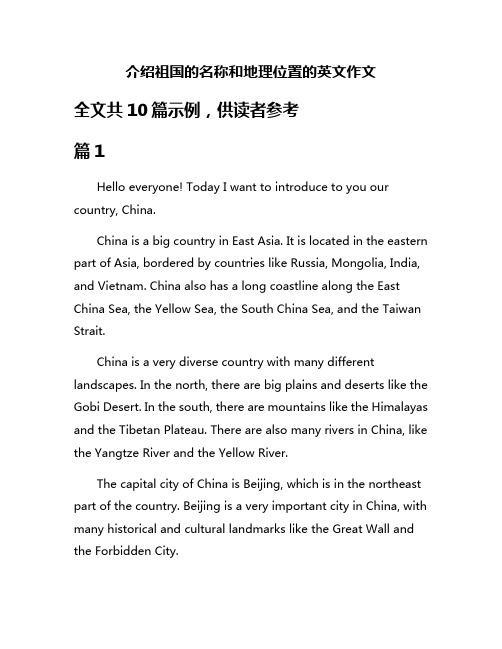
介绍祖国的名称和地理位置的英文作文全文共10篇示例,供读者参考篇1Hello everyone! Today I want to introduce to you our country, China.China is a big country in East Asia. It is located in the eastern part of Asia, bordered by countries like Russia, Mongolia, India, and Vietnam. China also has a long coastline along the East China Sea, the Yellow Sea, the South China Sea, and the Taiwan Strait.China is a very diverse country with many different landscapes. In the north, there are big plains and deserts like the Gobi Desert. In the south, there are mountains like the Himalayas and the Tibetan Plateau. There are also many rivers in China, like the Yangtze River and the Yellow River.The capital city of China is Beijing, which is in the northeast part of the country. Beijing is a very important city in China, with many historical and cultural landmarks like the Great Wall and the Forbidden City.China has a long history and rich culture. It is known for its inventions like paper, gunpowder, and the compass. Chinese people also have a unique language, writing system, and traditions like the Chinese New Year and dragon dances.I hope you enjoyed learning about China! Thank you for listening!篇2Hello everyone,I am a Chinese elementary student,and I want to introduce my country to you.My country’s name is China. It is located in East Asia and borders 14 countries, including Russia, Mongolia, India, and Vietnam. China is the third largest country in the world by land area.China has diverse geographical features, including mountains, plateaus, deserts, and plains. The Himalayas and the Tibetan Plateau are located in the southwestern part of the country. The Yangtze River and the Yellow River are two of the longest rivers in China.China is also home to many famous landmarks, such as the Great Wall, the Terracotta Army, and the Forbidden City. Thecountry has a rich history and culture that dates back thousands of years.In addition to its natural beauty and historical sites, China is also known for its delicious cuisine, including dishes like Peking duck, dumplings, and hot pot. Chinese New Year, also known as the Spring Festival, is the most important holiday in China and is celebrated with family gatherings, fireworks, and special meals.I hope you enjoyed learning about my country, China. Thank you for listening!篇3Hello everyone! Today I'm going to introduce to you the name and location of our country China.First of all, let's talk about the name of our country. Our country is called China, which means "Middle Kingdom" in Chinese. It's a very special name because it shows that China is in the middle of the world.Now, let's talk about the location of China. China is located in East Asia, and it is one of the largest countries in the world. China shares borders with 14 different countries, including Russia, Mongolia, India, and Vietnam.China has a very diverse geography. In the east, there are coastal plains and deltas, while in the west, there are high mountains like the Himalayas and the Tibetan Plateau. China also has many rivers, including the Yangtze River and the Yellow River.In conclusion, China is a beautiful and diverse country with a rich history and culture. I hope you enjoyed learning about the name and location of our country. Thank you for listening!篇4Hello everyone, today I want to introduce our country, China, to you all!China is a very big country in Asia. It is located in the eastern part of Asia and it is next to many other countries like Russia, India, and Japan. China has a lot of different landscapes like mountains, rivers, deserts, and forests. It is a very beautiful country!China is also known for having a very long history. People have been living in China for thousands of years and there are many ancient buildings and artifacts that show us how life was like a long time ago. One of the most famous landmarks in Chinais the Great Wall, which was built over 2,000 years ago to protect the country from invaders.In addition to its history and landscapes, China is also known for its delicious food. Chinese food is very diverse and there are many different kinds of dishes to try. Some popular Chinese dishes include dumplings, noodles, stir-fry, and rice.Overall, China is a very special country with a rich history, beautiful landscapes, and delicious food. I hope you have the chance to visit China one day and experience all the wonderful things it has to offer!篇5Hello everyone, today I'm going to introduce you to our motherland - China!China is a big country located in East Asia. It is bordered by 14 countries including Russia, India, and Japan. China is known for its vast land area and diverse landscapes, from mountains to deserts, and rivers to forests.The official name of our country is the People's Republic of China. It is the most populous country in the world, with over 1.4 billion people living here. The capital city of China is Beijing,where you can find famous landmarks like the Great Wall and the Forbidden City.China is also known for its rich history and culture. It is home to the oldest continuous civilization in the world, dating back thousands of years. We have famous inventions like paper, gunpowder, and the compass. Chinese cuisine is also popular worldwide, with dishes like dumplings, noodles, and Kung Pao chicken.In terms of natural beauty, China has a lot to offer. From the towering peaks of the Himalayas to the picturesque landscapes of Guilin, there is something for everyone to enjoy. The Yangtze River, the third longest river in the world, flows through China and is a popular tourist destination.Overall, China is a beautiful and diverse country with a rich history and culture. I am proud to call it my home and I hope you enjoyed learning more about it. Thank you for listening!篇6My country is called China. It is a very big country located in East Asia. China has a lot of different provinces and cities. Some famous cities in China are Beijing, Shanghai, and Guangzhou.China is surrounded by many countries like Russia, Mongolia, India, and Vietnam. It also has a lot of beautiful natural landscapes like mountains, rivers, and forests. The Great Wall of China is one of the most famous landmarks in the world.China is known for its delicious food like dumplings, noodles, and rice. We also have traditional festivals like the Chinese New Year and the Mid-Autumn Festival. People in China speak Mandarin as the main language, but there are also many different dialects spoken in different regions.I love my country China because it is a very special place witha rich history and culture. I am proud to be a Chinese and I hope that more people can visit my country to learn about its beauty and traditions. Thank you for reading my introduction to my country!篇7Hello everyone, I'm going to introduce our country's name and its location in a fun and easy way!Our country is called China. Have you heard of it before? It's a really big country in Asia. It's located in the eastern part of Asia, right beside countries like Russia, India, and Japan. China is known for its vast land and diverse landscapes.In the north of China, there are high mountains and cold weather. Have you heard of the famous Great Wall of China? It's a long wall that was built to protect China from invaders in the north. The Great Wall is one of the Seven Wonders of the World!In the south of China, there are lush green forests and tropical weather. The southern part of China is known for its delicious food like dumplings, noodles, and rice dishes. Have you tried any Chinese food before?In the west of China, there are deserts and dry plains. The famous Silk Road used to pass through this part of China, connecting China to the Middle East and Europe. People used to trade silk, spices, and goods along the Silk Road.In the east of China, there are big cities like Beijing, Shanghai, and Hong Kong. These cities are bustling with people, cars, and skyscrapers. Have you ever been to a big city before?So that's a little introduction to our country, China. I hope you learned something new and exciting about our country's name and location! Thank you for listening!篇8Hello everyone! Today I want to introduce you to our country, China.China is a big country in Asia. It is located in the eastern part of the continent. China is bordered by 14 countries including Russia, India, and Mongolia. It is also surrounded by the Pacific Ocean on the east side.The official name of our country is the People's Republic of China. It is one of the oldest civilizations in the world, with a history that dates back thousands of years. China is known for its rich culture, delicious food, and beautiful landscapes.China is a very diverse country. It has deserts, mountains, forests, and rivers. The Great Wall of China, one of the Seven Wonders of the World, is located in northern China. It is a famous landmark that attracts millions of tourists every year.China has a population of over 1.4 billion people, making it the most populous country in the world. The capital city of China is Beijing, which is known for its historic landmarks such as the Forbidden City and the Temple of Heaven.In China, we speak Mandarin Chinese, which is the official language of the country. We also have many different dialectsand ethnic groups, each with its own unique traditions and customs.I am proud to be a citizen of China, a country with a long and fascinating history. I hope you enjoyed learning a little bit about my country. Thank you for listening!篇9Hello everyone! Today, I am going to introduce our country's name and its geographical location.First of all, our country's name is the People's Republic of China. It is a beautiful country located in East Asia. China is a very big country with a population of over 1.4 billion people. The capital city of China is Beijing, and our country is known for its rich history, culture, and beautiful landscapes.China is bordered by 14 countries, including Russia, Mongolia, India, and Vietnam. It also has a vast coastline along the East China Sea, Yellow Sea, South China Sea, and the Pacific Ocean. China has a diverse geographical landscape, including mountains, deserts, rivers, and plateaus. The famous landmarks in China include the Great Wall, the Forbidden City, and the Terracotta Army.In addition to its diverse geography, China is also known for its delicious cuisine, traditional festivals, and ancient traditions. Chinese people are friendly and hardworking, and they take pride in their country's history and achievements.In conclusion, the People's Republic of China is a wonderful country with a rich culture and history. Its geographical location, diverse landscape, and friendly people make it a unique and special place. I hope you learned something new about our country today. Thank you for listening!篇10Hello everyone! Today, I'm going to introduce our country's name and its location.Our country is called China. It is a very big country located in East Asia. China is surrounded by many countries such as Russia, India, Vietnam, and Korea. It has a very long history and is known for its rich culture and traditions.China is a beautiful country with diverse landscapes. In the north, there are vast plains and deserts, while in the south, there are lush forests and mountains. The Yangtze River and the Yellow River are two of the most famous rivers in China. There are alsomany big cities like Beijing, Shanghai, and Guangzhou, where you can see modern buildings and busy streets.The Great Wall of China is one of the most famous landmarks in our country. It was built over 2,000 years ago to protect the country from invaders. The Terracotta Army in Xi'an is another famous archaeological site in China. It is a collection of life-size statues that were buried with the first Emperor of China.Overall, China is a wonderful country with a lot to offer. I am proud to be a citizen of such a beautiful and historical place. Let's all work together to protect and preserve our country for future generations. Thank you for listening to my introduction!。
中国地理介绍英文介绍
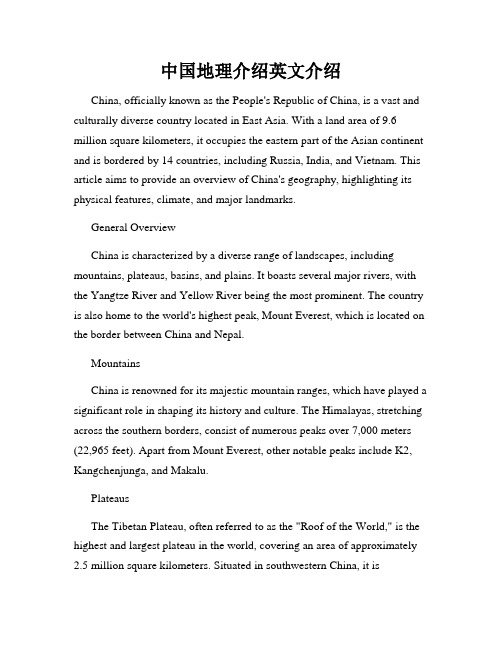
中国地理介绍英文介绍China, officially known as the People's Republic of China, is a vast and culturally diverse country located in East Asia. With a land area of 9.6 million square kilometers, it occupies the eastern part of the Asian continent and is bordered by 14 countries, including Russia, India, and Vietnam. This article aims to provide an overview of China's geography, highlighting its physical features, climate, and major landmarks.General OverviewChina is characterized by a diverse range of landscapes, including mountains, plateaus, basins, and plains. It boasts several major rivers, with the Yangtze River and Yellow River being the most prominent. The country is also home to the world's highest peak, Mount Everest, which is located on the border between China and Nepal.MountainsChina is renowned for its majestic mountain ranges, which have played a significant role in shaping its history and culture. The Himalayas, stretching across the southern borders, consist of numerous peaks over 7,000 meters (22,965 feet). Apart from Mount Everest, other notable peaks include K2, Kangchenjunga, and Makalu.PlateausThe Tibetan Plateau, often referred to as the "Roof of the World," is the highest and largest plateau in the world, covering an area of approximately 2.5 million square kilometers. Situated in southwestern China, it issurrounded by mountains and is renowned for its harsh climate and unique biodiversity.RiversChina's major rivers not only provide essential water resources but also serve as important transportation routes. The Yangtze River, with a total length of approximately 6,300 kilometers (3,915 miles), is the longest river in Asia and the third-longest in the world. It plays a crucial role in China's economy and is home to the famous Three Gorges Dam.The Yellow River, also known as the "Mother River of China," is the second-longest river in Asia. It originates in the Tibetan Plateau and flows through several provinces, providing water for irrigation and supporting agriculture in the region.PlainsChina's vast plains are essential for agriculture and settlement. The North China Plain, located between the Yangtze and Yellow Rivers, is one of the most densely populated regions in the country. Its fertile soil and favorable climate make it an ideal area for growing crops such as wheat, corn, and soybeans.DesertsThe Gobi Desert, situated in northern China and southern Mongolia, is the largest desert in Asia. It covers an area of approximately 1.3 million square kilometers and is known for its harsh and arid environment. Despite its challenging conditions, the Gobi Desert is rich in mineral resources such as coal, copper, and gold.ClimateChina's climate varies significantly due to its vast territory and diverse topography. In general, the country experiences four distinct seasons: spring, summer, autumn, and winter. However, regional differences result in variations such as the tropical climate in southern China and the arid climate in the northwest.Major LandmarksChina is home to numerous iconic landmarks that attract tourists from around the world. The Great Wall of China, stretching over 21,000 kilometers, is arguably the country's most well-known landmark. Built over centuries, it symbolizes China's historical strength and unity.The Forbidden City, located in Beijing, is another renowned landmark. With its intricate architecture and rich history, it served as the imperial palace for the Ming and Qing dynasties and now houses the Palace Museum.The Terracotta Army, discovered in Xi'an, showcases the burial site of the first Emperor of China, Qin Shi Huang. It consists of thousands of life-sized terracotta sculptures, including soldiers, horses, and chariots, representing the emperor's army in the afterlife.In conclusion, China's geography embodies a diverse range of physical features, including mountains, plateaus, rivers, plains, and deserts. Its climate varies across the vast territory, and it is home to several iconic landmarks that reflect the country's rich history and cultural heritage. Understanding China's geography is crucial in appreciating the country's complex and multifaceted identity.。
中国地理位置描写英语作文
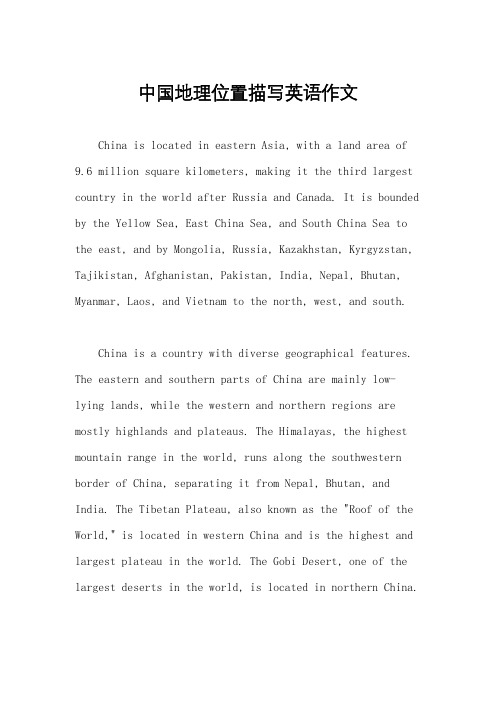
中国地理位置描写英语作文China is located in eastern Asia, with a land area of 9.6 million square kilometers, making it the third largest country in the world after Russia and Canada. It is bounded by the Yellow Sea, East China Sea, and South China Sea to the east, and by Mongolia, Russia, Kazakhstan, Kyrgyzstan, Tajikistan, Afghanistan, Pakistan, India, Nepal, Bhutan, Myanmar, Laos, and Vietnam to the north, west, and south.China is a country with diverse geographical features. The eastern and southern parts of China are mainly low-lying lands, while the western and northern regions are mostly highlands and plateaus. The Himalayas, the highest mountain range in the world, runs along the southwestern border of China, separating it from Nepal, Bhutan, and India. The Tibetan Plateau, also known as the "Roof of the World," is located in western China and is the highest and largest plateau in the world. The Gobi Desert, one of the largest deserts in the world, is located in northern China.China has a vast coastline that stretches over 18,000 kilometers, making it the third longest coastline in the world after Canada and Indonesia. The coast is dotted with numerous ports and harbors, including Shanghai, Guangzhou, and Hong Kong, which are among the busiest ports in the world.China's climate is also diverse, ranging from tropical in the south to subarctic in the north. The country experiences four distinct seasons, with hot summers and cold winters. The monsoon season, which brings heavy rainfall, occurs in the summer months.In addition to its diverse geography, China is also home to a rich and diverse culture. The country has a long and fascinating history, with a civilization that dates back more than 5,000 years. China is known for its art, literature, philosophy, and cuisine, which have all had a profound influence on the world.Despite its size and diversity, China is a unified country with a strong sense of national identity. Thecountry is home to more than 1.4 billion people, making it the most populous country in the world. The Chinese people are known for their hard work, resilience, and determination, and these qualities have helped them build a prosperous and powerful nation.In conclusion, China's geographical location has played a significant role in shaping its history, culture, and economy. Its diverse geography, rich culture, and strong sense of national identity make it a fascinating and complex country that continues to capture the world's imagination.。
中国地理位置英文介绍
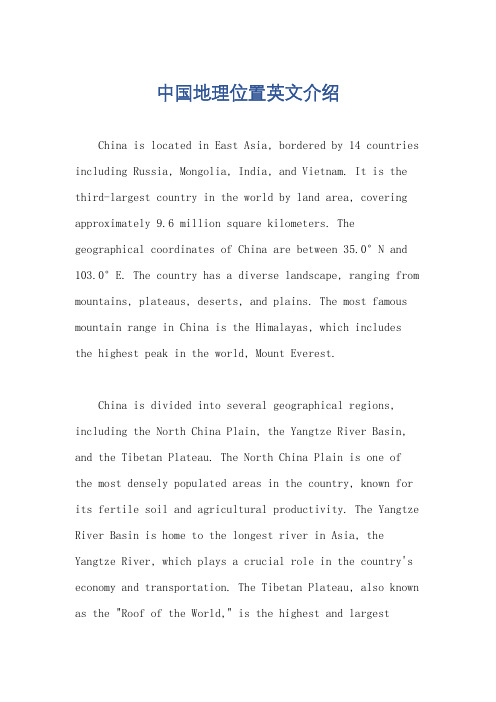
中国地理位置英文介绍China is located in East Asia, bordered by 14 countries including Russia, Mongolia, India, and Vietnam. It is the third-largest country in the world by land area, covering approximately 9.6 million square kilometers. The geographical coordinates of Chi na are between 35.0°N and 103.0°E. The country has a diverse landscape, ranging from mountains, plateaus, deserts, and plains. The most famous mountain range in China is the Himalayas, which includes the highest peak in the world, Mount Everest.China is divided into several geographical regions, including the North China Plain, the Yangtze River Basin, and the Tibetan Plateau. The North China Plain is one of the most densely populated areas in the country, known for its fertile soil and agricultural productivity. The Yangtze River Basin is home to the longest river in Asia, the Yangtze River, which plays a crucial role in the country's economy and transportation. The Tibetan Plateau, also known as the "Roof of the World," is the highest and largestplateau in the world, with an average elevation of over4,500 meters.In addition to its diverse landscape, China is also known for its rich biodiversity. The country is home to a wide variety of plant and animal species, including the giant panda, snow leopard, and golden monkey. China has established numerous national parks and nature reserves to protect its unique ecosystems and wildlife. The country's geographical location also influences its climate, with regions experiencing a wide range of temperatures and precipitation levels throughout the year.China's geographical location has played a significant role in shaping its history and culture. The country has been influenced by various neighboring civilizations, including those of India, Central Asia, and Southeast Asia. China's strategic position along the ancient Silk Road facilitated trade and cultural exchange with other regions, leading to the spread of ideas, technologies, and goods. The country's geographical features, such as the Great Wall and the Yangtze River, have also played a crucial role inits defense and transportation systems.Overall, China's geographical location is a key factor in its economic, political, and cultural development. The country's diverse landscape, rich biodiversity, and strategic position have influenced its history, society, and environment. China's geographical features continue to shape its future as the country strives to balance economic growth with environmental conservation and sustainable development.。
英文介绍中国地理位置

英文介绍中国地理位置China Geographical LocationChina, officially known as the People's Republic of China (PRC), is a vast country situated in Eastern Asia. With a land area of approximately 9.6 million square kilometers, it is the third-largest country in the world, extending across multiple geographical regions. Positioned in the northern hemisphere, China is located between latitudes 18° and 53°N and longitudes 73° and 135°E. Its extensive territory stretches from the East China Sea in the east to the Pamir Mountains in the west, and from the Gobi Desert in the north to the tropical forests of Southeast Asia in the south.Bordering 14 countries, China has the longest international land border, spanning approximately 22,000 kilometers. It shares its borders with Afghanistan, Bhutan, India, Kazakhstan, Kyrgyzstan, Laos, Mongolia, Myanmar, Nepal, North Korea, Pakistan, Russia, Tajikistan, and Vietnam. Due to its vast territorial expanse, China is known for its incredible geographic diversity, ranging from high mountain ranges to expansive plateaus, from arid deserts to fertile plains, and from frigid tundra to tropical rainforests.China's eastern coastline stretches for about 18,000 kilometers, bordering the East China Sea, Yellow Sea, and South China Sea. It has numerous major ports, including Shanghai, Guangzhou, and Qingdao, which have played significant roles in international trade and commerce.China is internationally recognized for its unique geographic features, such as the Himalayan mountain range, which includes the world's highestpeak, Mount Everest, situated on the China-Nepal border. The Yangtze River, the third-longest river globally, flows through the heart of China, contributing to the fertility and prosperity of the central plains. Additionally, the Yellow River, known as the "Mother River of China," has played a pivotal role in shaping Chinese civilization throughout history.In terms of climate, China experiences a wide range of weather patterns due to its vast size and complex terrain. The country possesses diverse climatic zones, including tropical in the southernmost areas, sub-tropical in the southeast, arid and semi-arid in the northwest, and continental in the north. This climatic diversity influences the country's agricultural production, natural resources, and overall economic development.China's geographical location has bestowed it with strategic importance both regionally and globally. It serves as a bridge connecting East Asia, Central Asia, and South Asia, playing a crucial role in cultural exchange, trade routes, and geopolitical affairs. China's location has also contributed to its rich history, with numerous dynasties rising and falling over millennia, leaving behind a significant cultural heritage.In conclusion, China's geographical location is diverse and extensive, offering a multitude of natural wonders and resources. Its position in Eastern Asia and its vast territorial expanse make it a vital player on the global stage. From the majestic Himalayas to the bustling coastal cities, China's geography has shaped both its physical landscape and its cultural identity.。
描述中国的地理位置英语作文
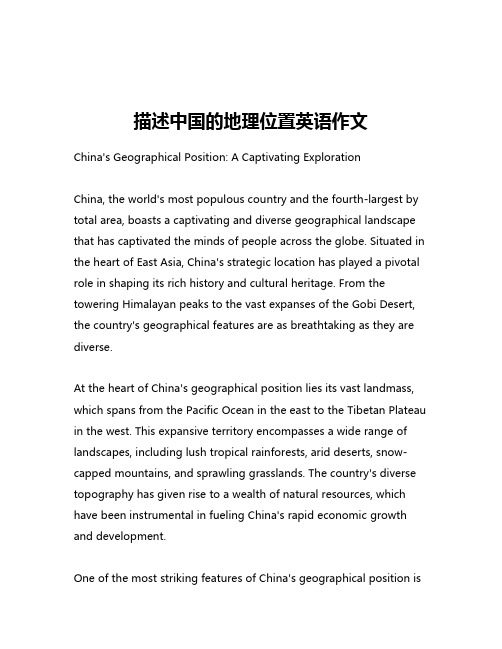
描述中国的地理位置英语作文China's Geographical Position: A Captivating ExplorationChina, the world's most populous country and the fourth-largest by total area, boasts a captivating and diverse geographical landscape that has captivated the minds of people across the globe. Situated in the heart of East Asia, China's strategic location has played a pivotal role in shaping its rich history and cultural heritage. From the towering Himalayan peaks to the vast expanses of the Gobi Desert, the country's geographical features are as breathtaking as they are diverse.At the heart of China's geographical position lies its vast landmass, which spans from the Pacific Ocean in the east to the Tibetan Plateau in the west. This expansive territory encompasses a wide range of landscapes, including lush tropical rainforests, arid deserts, snow-capped mountains, and sprawling grasslands. The country's diverse topography has given rise to a wealth of natural resources, which have been instrumental in fueling China's rapid economic growth and development.One of the most striking features of China's geographical position isits proximity to the Pacific Ocean. The country's eastern coastline, which stretches for over 14,500 kilometers, is dotted with bustling port cities and thriving economic hubs. These coastal regions have played a crucial role in China's integration with the global economy, serving as gateways for international trade and investment.Beyond its coastal regions, China's geographical position is defined by its landlocked borders, which share boundaries with 14 other countries. This strategic location has made China a hub of regional and global geopolitical influence, with the country's policies and actions having far-reaching implications for its neighbors and the international community.One of the most significant aspects of China's geographical position is its proximity to the Himalayan mountain range, which forms the country's western border. The Himalayas, often referred to as the "Roof of the World," are a formidable natural barrier that have played a crucial role in shaping China's history and culture. The region's harsh climate and rugged terrain have long been a source of both fascination and challenge for explorers and adventurers alike.China's geographical position has also been shaped by its vast river systems, which have played a central role in the country's agricultural and economic development. The Yangtze River, the world's third-longest river, flows through the heart of China, while the Yellow River,often referred to as the "Mother River of China," has been a crucial source of life and sustenance for the country's people for thousands of years.The country's diverse geographical features have also given rise to a rich tapestry of cultural traditions and practices. From the ancient Silk Road trade routes that connected China to the West, to the intricate system of canals and waterways that have facilitated domestic trade and transportation, the country's geography has been a driving force behind its cultural and economic development.In conclusion, China's geographical position is a complex and multifaceted phenomenon that has played a crucial role in shaping the country's history, culture, and economic development. From its vast landmass and diverse landscapes to its strategic location at the heart of East Asia, China's geographical features have captivated the minds of people around the world and continue to be a source of fascination and wonder.。
中国地理位置的英语介绍
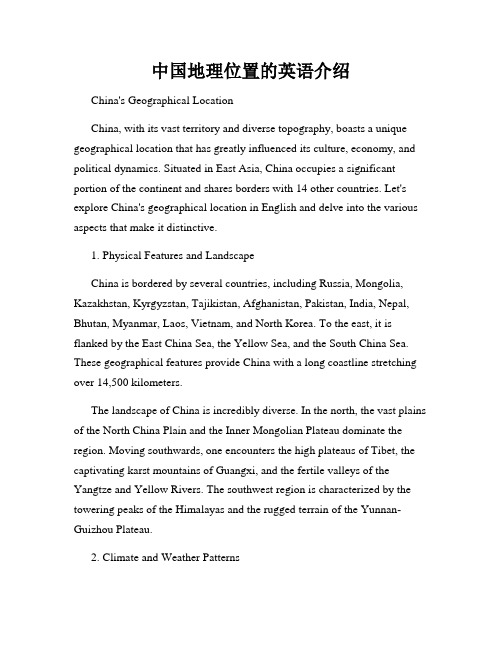
中国地理位置的英语介绍China's Geographical LocationChina, with its vast territory and diverse topography, boasts a unique geographical location that has greatly influenced its culture, economy, and political dynamics. Situated in East Asia, China occupies a significant portion of the continent and shares borders with 14 other countries. Let's explore China's geographical location in English and delve into the various aspects that make it distinctive.1. Physical Features and LandscapeChina is bordered by several countries, including Russia, Mongolia, Kazakhstan, Kyrgyzstan, Tajikistan, Afghanistan, Pakistan, India, Nepal, Bhutan, Myanmar, Laos, Vietnam, and North Korea. To the east, it is flanked by the East China Sea, the Yellow Sea, and the South China Sea. These geographical features provide China with a long coastline stretching over 14,500 kilometers.The landscape of China is incredibly diverse. In the north, the vast plains of the North China Plain and the Inner Mongolian Plateau dominate the region. Moving southwards, one encounters the high plateaus of Tibet, the captivating karst mountains of Guangxi, and the fertile valleys of the Yangtze and Yellow Rivers. The southwest region is characterized by the towering peaks of the Himalayas and the rugged terrain of the Yunnan-Guizhou Plateau.2. Climate and Weather PatternsChina's geographical location influences its climate, which varies significantly from region to region. The country experiences a range of climatic zones, including cold-temperate in the north, sub-tropical in the south, and arid and alpine in the west.The northern parts of China, such as Beijing and Harbin, have cold winters with temperatures well below freezing. Summers tend to be shorter but can be hot and humid. On the other hand, cities in southern China, like Guangzhou and Shanghai, have milder winters and longer, hot, and humid summers. The southwestern region, including Chengdu and Kunming, enjoys a more moderate climate due to its higher elevation, with mild winters and pleasant summers.3. Economic SignificanceChina's geographical location has played a crucial role in its economic development. The vast coastline has facilitated maritime trade, transforming China into one of the world's largest exporters and importers. Ports such as Shanghai, Shenzhen, and Qingdao serve as important hubs for international trade.Moreover, China's position at the crossroads of Central Asia and Southeast Asia has allowed for the development of extensive transportation networks, including the famous Silk Road. China's connectivity with neighboring countries promotes trade and cultural exchanges, contributing to its economic growth.4. Political ImplicationsChina's geographical location has also had significant political implications throughout history. The natural barriers created by its vast mountains and deserts served as a defense mechanism against invasions, contributing to its historical unity and cultural continuity.Furthermore, China's borders with various countries have occasionally resulted in geopolitical tensions. The border disputes with India, for instance, highlight the complex political dynamics arising from its geographical location. However, China has also fostered diplomatic relationships with its neighbors, engaging in regional cooperation and initiatives such as the Belt and Road Initiative.In conclusion, China's geographical location shapes its physical features, climate patterns, economic significance, and political implications. Its vast territory and diverse landscapes contribute to its rich cultural heritage, while its diverse climate zones foster agricultural productivity. The country's coastal access and central position in Asia have facilitated economic growth and regional connectivity. Understanding China's geographical location is essential to appreciating the country's significance on the global stage and its ongoing development.。
中国地理英文介绍
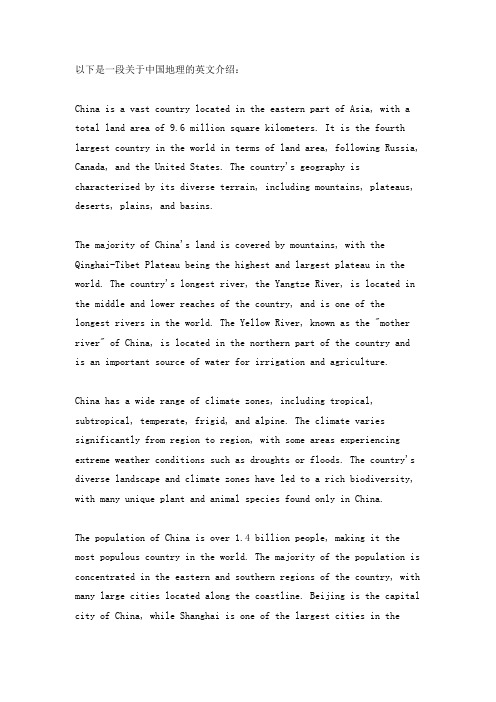
以下是一段关于中国地理的英文介绍:China is a vast country located in the eastern part of Asia, with a total land area of 9.6 million square kilometers. It is the fourth largest country in the world in terms of land area, following Russia, Canada, and the United States. The country's geography is characterized by its diverse terrain, including mountains, plateaus, deserts, plains, and basins.The majority of China's land is covered by mountains, with the Qinghai-Tibet Plateau being the highest and largest plateau in the world. The country's longest river, the Yangtze River, is located in the middle and lower reaches of the country, and is one of the longest rivers in the world. The Yellow River, known as the "mother river" of China, is located in the northern part of the country andis an important source of water for irrigation and agriculture.China has a wide range of climate zones, including tropical, subtropical, temperate, frigid, and alpine. The climate varies significantly from region to region, with some areas experiencing extreme weather conditions such as droughts or floods. The country's diverse landscape and climate zones have led to a rich biodiversity, with many unique plant and animal species found only in China.The population of China is over 1.4 billion people, making it the most populous country in the world. The majority of the population is concentrated in the eastern and southern regions of the country, with many large cities located along the coastline. Beijing is the capital city of China, while Shanghai is one of the largest cities in theworld and is a major economic center.China's economy is the second largest in the world, with a strong focus on manufacturing, services, and technology. The country has also become a major player in global trade and investment, with many multinational companies headquartered in China. Tourism is also a growing sector in China, with many historical and culturalattractions drawing millions of tourists each year.In conclusion, China is a vast and diverse country with a richhistory and culture. Its unique geography, including mountains, plateaus, deserts, plains, and basins, coupled with its wide range of climate zones and biodiversity, make it one of the most interesting and complex countries in the world.。
英语作文介绍一下中国地理位置
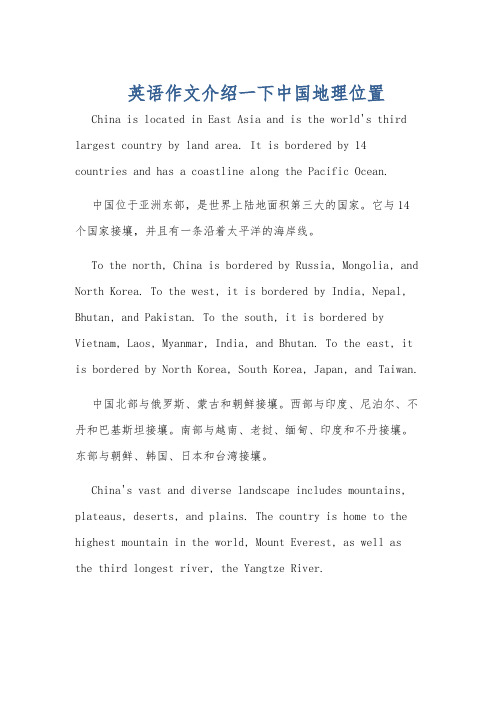
英语作文介绍一下中国地理位置China is located in East Asia and is the world's third largest country by land area. It is bordered by 14 countries and has a coastline along the Pacific Ocean.中国位于亚洲东部,是世界上陆地面积第三大的国家。
它与14个国家接壤,并且有一条沿着太平洋的海岸线。
To the north, China is bordered by Russia, Mongolia, and North Korea. To the west, it is bordered by India, Nepal, Bhutan, and Pakistan. To the south, it is bordered by Vietnam, Laos, Myanmar, India, and Bhutan. To the east, it is bordered by North Korea, South Korea, Japan, and Taiwan.中国北部与俄罗斯、蒙古和朝鲜接壤。
西部与印度、尼泊尔、不丹和巴基斯坦接壤。
南部与越南、老挝、缅甸、印度和不丹接壤。
东部与朝鲜、韩国、日本和台湾接壤。
China's vast and diverse landscape includes mountains, plateaus, deserts, and plains. The country is home to the highest mountain in the world, Mount Everest, as well as the third longest river, the Yangtze River.中国广阔而多样的地形包括山脉、高原、沙漠和平原。
中国的地理概括英语作文
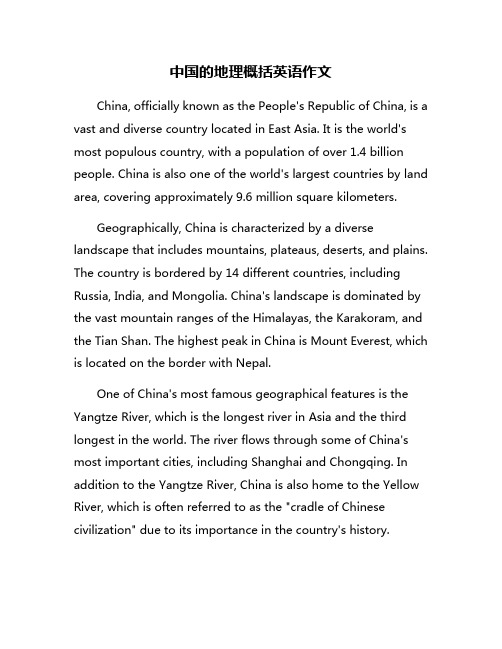
中国的地理概括英语作文China, officially known as the People's Republic of China, is a vast and diverse country located in East Asia. It is the world's most populous country, with a population of over 1.4 billion people. China is also one of the world's largest countries by land area, covering approximately 9.6 million square kilometers.Geographically, China is characterized by a diverse landscape that includes mountains, plateaus, deserts, and plains. The country is bordered by 14 different countries, including Russia, India, and Mongolia. China's landscape is dominated by the vast mountain ranges of the Himalayas, the Karakoram, and the Tian Shan. The highest peak in China is Mount Everest, which is located on the border with Nepal.One of China's most famous geographical features is the Yangtze River, which is the longest river in Asia and the third longest in the world. The river flows through some of China's most important cities, including Shanghai and Chongqing. In addition to the Yangtze River, China is also home to the Yellow River, which is often referred to as the "cradle of Chinese civilization" due to its importance in the country's history.China's climate varies greatly depending on the region. In the north, winters are cold and dry, while in the south, summers are hot and humid. The country experiences a wide range of weather patterns, including typhoons, droughts, and sandstorms.In recent years, China has become one of the world's leading economies and a major global player. The country is known for its rapid industrialization and urbanization, as well as its rich cultural heritage. China's geography has played a crucial role in shaping its development, from the fertile lands of the Yangtze River Valley to the mineral-rich regions of the west.Overall, China's geography is as diverse and dynamic as its people. The country's vast size, varied landscape, and rich history make it a fascinating and complex place to explore. Whether you are hiking in the mountains, exploring ancient temples, or discovering bustling cities, China offers a wealth of experiences for travelers and researchers alike.。
中国地理位置简介作文英语
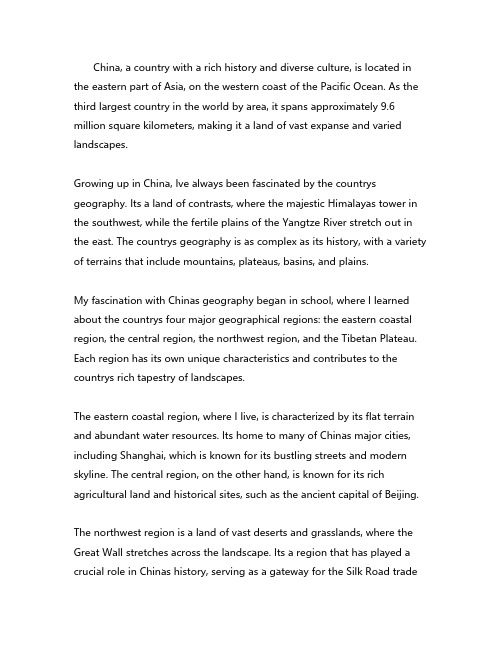
China, a country with a rich history and diverse culture, is located in the eastern part of Asia, on the western coast of the Pacific Ocean. As the third largest country in the world by area, it spans approximately 9.6 million square kilometers, making it a land of vast expanse and varied landscapes.Growing up in China, Ive always been fascinated by the countrys geography. Its a land of contrasts, where the majestic Himalayas tower in the southwest, while the fertile plains of the Yangtze River stretch out in the east. The countrys geography is as complex as its history, with a variety of terrains that include mountains, plateaus, basins, and plains.My fascination with Chinas geography began in school, where I learned about the countrys four major geographical regions: the eastern coastal region, the central region, the northwest region, and the Tibetan Plateau. Each region has its own unique characteristics and contributes to the countrys rich tapestry of landscapes.The eastern coastal region, where I live, is characterized by its flat terrain and abundant water resources. Its home to many of Chinas major cities, including Shanghai, which is known for its bustling streets and modern skyline. The central region, on the other hand, is known for its rich agricultural land and historical sites, such as the ancient capital of Beijing.The northwest region is a land of vast deserts and grasslands, where the Great Wall stretches across the landscape. Its a region that has played a crucial role in Chinas history, serving as a gateway for the Silk Road traderoutes. The Tibetan Plateau, often referred to as the Roof of the World, is a highaltitude region with a unique ecosystem and breathtaking scenery.Chinas geography is not only diverse but also strategically important. Its location on the eastern coast of Asia has made it a key player in international trade and diplomacy. The countrys vast land area and rich natural resources have also contributed to its economic growth and development.One of the most striking aspects of Chinas geography is its river systems. The Yangtze and Yellow Rivers are two of the most important rivers in China, providing water for agriculture, industry, and daily life. The Yangtze River, the longest river in Asia, flows through several provinces and is a vital source of hydroelectric power.Chinas geography also plays a significant role in its climate. The country experiences a range of climates, from the cold winters of the north to the tropical summers of the south. This diversity in climate has led to a rich variety of flora and fauna, making China one of the most biodiverse countries in the world.In conclusion, Chinas geography is a testament to the countrys vastness and diversity. From the towering mountains of the west to the fertile plains of the east, each region has its own unique characteristics that contribute to the countrys rich cultural heritage. As a Chinese high school student, I am proud of my countrys geographical diversity and the opportunities it provides for exploration and learning.。
英语作文介绍一下中国地理位置
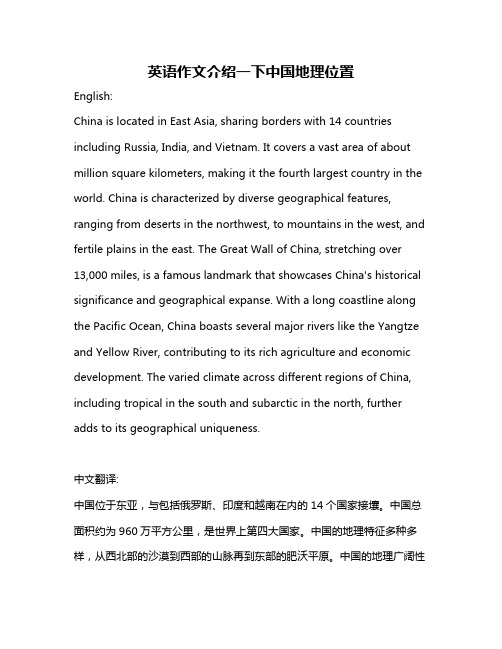
英语作文介绍一下中国地理位置English:China is located in East Asia, sharing borders with 14 countries including Russia, India, and Vietnam. It covers a vast area of about million square kilometers, making it the fourth largest country in the world. China is characterized by diverse geographical features, ranging from deserts in the northwest, to mountains in the west, and fertile plains in the east. The Great Wall of China, stretching over 13,000 miles, is a famous landmark that showcases China's historical significance and geographical expanse. With a long coastline along the Pacific Ocean, China boasts several major rivers like the Yangtze and Yellow River, contributing to its rich agriculture and economic development. The varied climate across different regions of China, including tropical in the south and subarctic in the north, further adds to its geographical uniqueness.中文翻译:中国位于东亚,与包括俄罗斯、印度和越南在内的14个国家接壤。
中国地理介绍(英语版)

青藏高原是世界上最高最大的高原,素有世界屋 脊之称。喜马拉雅山脉的珠穆朗玛峰位于中国和 尼泊尔边界,海拔8848.13米,是世界上最高的 山峰。 The Qinghai-Tibet Plateau is the highest and largest plateau wห้องสมุดไป่ตู้ich is commonly know as the “roof of the world”. Qomolangma in the Himalayas Mountains is located on the border between China and Nepal, being the world’s highest peak, having an elevation of 8848.13 meters.
The Changjiang River/ Yangtze River
长江是中国的生命线。它流经10个省市,有 700多条支流,流域面积为180余万平方公里, 占中国陆地总面积的19%。长江流经中国的主 要工业区,形成华南人口密度最大的三角洲。 The Yangtze River is China’s lifeline. The river flows through ten provinces, with over 700 tributaries, covers an area of 1.8 million km, which is 19 percent of the total land area of China. The river flows through the major industrialized area in China, and forms the most densely populated delta.
- 1、下载文档前请自行甄别文档内容的完整性,平台不提供额外的编辑、内容补充、找答案等附加服务。
- 2、"仅部分预览"的文档,不可在线预览部分如存在完整性等问题,可反馈申请退款(可完整预览的文档不适用该条件!)。
- 3、如文档侵犯您的权益,请联系客服反馈,我们会尽快为您处理(人工客服工作时间:9:00-18:30)。
1-1地理位置
中国位于亚洲东部、太平洋西岸。
国土面积约960万平方千米,仅次于俄罗斯和加拿大,位居世界第三位。
中国疆域东西横跨整个东亚大陆的5200千米,中国地形多样,其东面和南面,频临海岸线,多为低地与丘陵,地势平缓,土壤肥沃,全国大部分农业作物和人口都集聚于此;其西部和北部,多为凹陷的盆地(戈壁滩、塔克拉玛干)、起伏的高原和高耸的山丘,世界之最的青藏高原也在这块区域中,这里不宜种植农业作物,人口稀少。
从传统意义上来讲,中国人口集中分布在其中部平原,一直以来中国以开发自己巨大的内陆市场为导向,逐渐在北部平原上发展起以长江中下游平原为中心的庞大市场力量。
近些年来,长达1.8万多千米的海岸线一直都进行广泛的出口导向贸易,这种力量转换使得沿海城市的经济成为了中国经济的领头羊。
与美国所占面积接近,中国国土面积约960万平方千米,仅次于俄罗斯和加拿大,位居世界第三位。
China stretches some 5200 kilometers across the East Asian landmass. Its physical features are multiples. The eastern and southern half of the country, its seacoast fringed with offshore
islands, is a region of fertile lowlands and foothills with most of the agricultural output and human population. The western and northern half of China is a region of sunken basins (Gobi, Taklamakan), rolling plateaus, and towering massifs, including a portion of the highest tableland on earth (Tibetan Plateau) with lower agricultural possibilities and thus, far less populated.
Traditionally, the Chinese population centered on the Chinese central plain and oriented itself toward its own enormous inland market, developing as an imperial power whose center lay in the middle and lower reaches of the Yellow River on the northern plains, More recently, the 18000-kilometers coastline have been used extensively for export-oriented trade, making a power shift, with the coastline provinces becoming the leading economic center.
With and area of about 9.6 million km2,the People’s Republic of China is the 3rd largest country in total area behind Russia and Canada, and very similar to the United States.。
